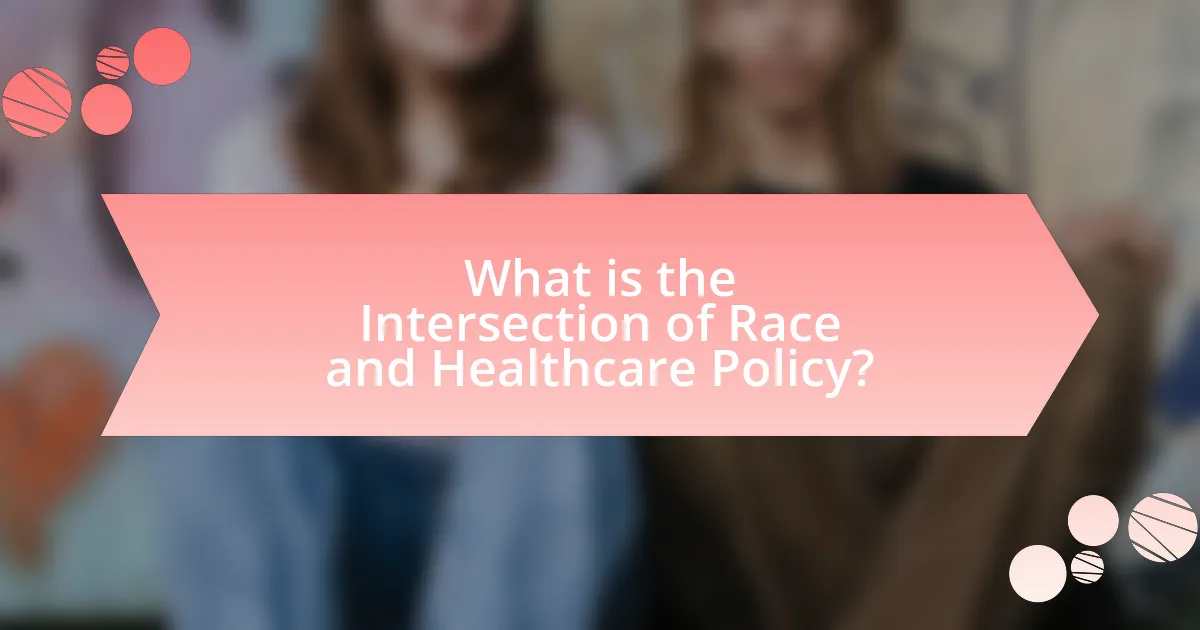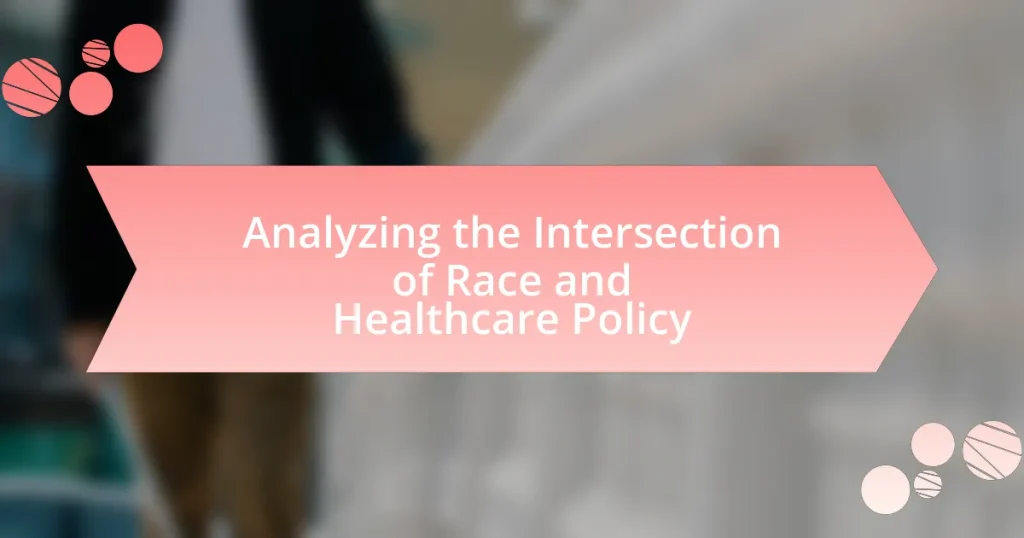The article analyzes the intersection of race and healthcare policy, highlighting how racial and ethnic disparities shape healthcare access, treatment, and outcomes. It discusses the historical contexts of these disparities, the influence of socioeconomic factors, and the importance of addressing systemic racism in healthcare policies. Key frameworks for understanding these issues, such as Critical Race Theory and the Social Determinants of Health, are examined, along with current challenges and barriers to implementing equitable healthcare policies. The article emphasizes the need for community engagement, education, and targeted interventions to improve healthcare equity and outcomes for marginalized populations.

What is the Intersection of Race and Healthcare Policy?
The intersection of race and healthcare policy refers to how racial and ethnic disparities influence the formulation, implementation, and outcomes of healthcare policies. Research indicates that systemic racism contributes to unequal access to healthcare services, resulting in poorer health outcomes for marginalized racial groups. For instance, a study published in the American Journal of Public Health found that Black Americans are more likely to experience barriers to healthcare access, leading to higher rates of chronic diseases compared to their white counterparts. This intersection highlights the need for policies that address these disparities to promote health equity and improve overall public health outcomes.
How does race influence healthcare access and outcomes?
Race significantly influences healthcare access and outcomes through systemic disparities in treatment and resource allocation. Studies show that racial and ethnic minorities often face barriers such as lack of insurance, lower quality of care, and implicit bias from healthcare providers. For instance, the National Healthcare Quality and Disparities Report indicates that Black and Hispanic populations are more likely to experience unmet healthcare needs compared to their white counterparts. Additionally, research published in the Journal of the American Medical Association highlights that Black patients receive fewer pain management interventions than white patients, leading to poorer health outcomes. These disparities illustrate how race shapes both the accessibility of healthcare services and the effectiveness of care received.
What are the historical contexts of racial disparities in healthcare?
Racial disparities in healthcare have historical contexts rooted in systemic racism, segregation, and discriminatory policies. For instance, the establishment of Jim Crow laws in the late 19th century enforced racial segregation in healthcare facilities, leading to unequal access and quality of care for Black Americans. Additionally, the Tuskegee Syphilis Study, conducted from 1932 to 1972, exemplified unethical treatment and exploitation of Black individuals in medical research, further eroding trust in the healthcare system. These historical injustices have contributed to ongoing disparities, as evidenced by studies showing that racial and ethnic minorities continue to experience higher rates of chronic illnesses and lower access to healthcare services compared to their white counterparts.
How do socioeconomic factors intersect with race in healthcare?
Socioeconomic factors significantly intersect with race in healthcare by influencing access to medical services, quality of care, and health outcomes. For instance, individuals from racial and ethnic minority groups often experience higher rates of poverty, lower levels of education, and limited access to health insurance, which collectively contribute to disparities in healthcare access. According to the U.S. Department of Health and Human Services, racial minorities are more likely to be uninsured compared to their white counterparts, leading to reduced access to preventive care and treatment. Additionally, studies show that socioeconomic status can affect the quality of care received; for example, Black patients are less likely to receive timely and appropriate treatments for chronic conditions compared to white patients, as highlighted in research published in the Journal of Health Care for the Poor and Underserved. This intersection of race and socioeconomic factors creates a compounded disadvantage, perpetuating health inequities across different populations.
Why is it important to analyze race in healthcare policy?
Analyzing race in healthcare policy is crucial because it helps identify and address health disparities among different racial and ethnic groups. Research indicates that systemic racism and socioeconomic factors contribute to unequal access to healthcare, leading to poorer health outcomes for marginalized populations. For instance, the Centers for Disease Control and Prevention (CDC) reports that Black Americans are more likely to suffer from chronic conditions such as hypertension and diabetes compared to their white counterparts. By examining race in healthcare policy, policymakers can develop targeted interventions that promote equity, improve health outcomes, and ensure that all individuals receive appropriate care regardless of their racial background.
What are the implications of ignoring race in healthcare policy?
Ignoring race in healthcare policy leads to significant disparities in health outcomes among different racial and ethnic groups. When race is not considered, policies may fail to address the unique social determinants of health that affect marginalized communities, resulting in inadequate access to care, poorer quality of treatment, and higher rates of chronic diseases. For instance, studies show that Black Americans are more likely to experience higher mortality rates from conditions like heart disease and diabetes due to systemic inequities in healthcare access and treatment. Additionally, the lack of race-conscious policies can perpetuate biases in medical research and clinical practices, further entrenching health inequities.
How can understanding race improve healthcare delivery?
Understanding race can improve healthcare delivery by enabling providers to tailor medical care to the specific needs of diverse populations. This tailored approach can address health disparities that exist among different racial and ethnic groups, leading to more effective treatment and better health outcomes. For instance, research from the American Journal of Public Health indicates that culturally competent care can reduce hospital readmission rates and improve patient satisfaction among minority groups. By recognizing and addressing the unique social determinants of health that affect various racial communities, healthcare systems can implement targeted interventions that enhance access to care and promote equity in health outcomes.
What frameworks exist for analyzing race and healthcare policy?
Several frameworks exist for analyzing race and healthcare policy, including Critical Race Theory (CRT), the Social Determinants of Health (SDOH) framework, and the Health Equity Framework. Critical Race Theory examines how systemic racism influences healthcare access and outcomes, emphasizing the role of social constructs in shaping health disparities. The Social Determinants of Health framework identifies factors such as socioeconomic status, education, and environment that contribute to health inequities among racial groups. The Health Equity Framework focuses on ensuring fair access to healthcare resources and addressing the root causes of health disparities, advocating for policies that promote equity across different racial and ethnic populations. These frameworks provide structured approaches to understanding and addressing the complex interplay between race and healthcare policy.
What role do social determinants of health play in this analysis?
Social determinants of health significantly influence the analysis of race and healthcare policy by shaping access to resources, healthcare services, and overall health outcomes. These determinants, including socioeconomic status, education, and neighborhood environment, create disparities that affect racial and ethnic groups differently. For instance, research from the World Health Organization indicates that individuals in lower socioeconomic brackets experience higher rates of chronic diseases, which underscores the impact of social determinants on health equity. Thus, understanding these factors is crucial for developing effective healthcare policies that address racial disparities and promote equitable health outcomes.
How do different healthcare systems address racial disparities?
Different healthcare systems address racial disparities through targeted policies, community engagement, and data collection. For instance, the Affordable Care Act in the United States expanded access to healthcare for minority populations, aiming to reduce gaps in insurance coverage. Additionally, the National Health Service in the United Kingdom implements initiatives to ensure equitable access to services for diverse ethnic groups, focusing on culturally competent care. Research indicates that these systems utilize data to identify disparities and develop interventions; for example, a study published in the Journal of Health Affairs found that states with Medicaid expansion saw a significant decrease in racial disparities in access to care.

What are the Current Challenges in Addressing Racial Disparities in Healthcare?
Current challenges in addressing racial disparities in healthcare include systemic bias, socioeconomic factors, and access to care. Systemic bias manifests in healthcare provider attitudes and institutional policies that disadvantage racial minorities, leading to unequal treatment outcomes. Socioeconomic factors, such as income and education levels, further exacerbate these disparities, as individuals from marginalized communities often face barriers to accessing quality healthcare services. Additionally, geographic location plays a crucial role, with many minority populations residing in areas with fewer healthcare resources. According to the National Healthcare Quality and Disparities Report, racial and ethnic minorities continue to experience higher rates of chronic diseases and lower access to preventive services, highlighting the persistent nature of these challenges.
What barriers exist in implementing equitable healthcare policies?
Barriers in implementing equitable healthcare policies include systemic racism, socioeconomic disparities, and lack of political will. Systemic racism manifests in biased healthcare practices and unequal access to resources, which disproportionately affect marginalized communities. Socioeconomic disparities create significant obstacles, as individuals from lower-income backgrounds often face barriers such as inadequate insurance coverage and limited access to quality care. Additionally, the lack of political will can hinder the development and enforcement of policies aimed at promoting equity, as policymakers may prioritize other issues over healthcare reform. These factors collectively impede the realization of equitable healthcare for all populations.
How do implicit biases affect healthcare providers’ decisions?
Implicit biases significantly influence healthcare providers’ decisions by affecting their perceptions and interactions with patients. Research indicates that these biases can lead to disparities in treatment recommendations, diagnostic accuracy, and patient-provider communication. For instance, a study published in the Journal of the American Medical Association found that Black patients are less likely to receive pain medication compared to white patients due to implicit biases held by healthcare providers. This demonstrates that unconscious stereotypes can result in unequal treatment, ultimately impacting patient outcomes and perpetuating health disparities.
What role does legislation play in addressing these barriers?
Legislation plays a crucial role in addressing barriers related to race and healthcare policy by establishing legal frameworks that promote equity and access to healthcare services. For instance, laws such as the Affordable Care Act have expanded healthcare coverage to millions, particularly among racial and ethnic minorities who historically faced disparities in access. Additionally, legislation can enforce anti-discrimination measures, ensuring that healthcare providers deliver services without bias based on race. The implementation of such laws is supported by data showing that states with stronger healthcare regulations experience improved health outcomes among diverse populations, thereby validating the effectiveness of legislative action in mitigating healthcare disparities.
How do community health initiatives address racial disparities?
Community health initiatives address racial disparities by implementing targeted programs that focus on the specific health needs of marginalized racial groups. These initiatives often include culturally competent care, outreach efforts, and education tailored to the unique challenges faced by these communities. For example, the Centers for Disease Control and Prevention (CDC) has reported that community health workers can effectively reduce health disparities by providing resources and support directly within underserved populations. Additionally, initiatives like the Healthy People 2030 framework emphasize the importance of addressing social determinants of health, which disproportionately affect racial minorities, thereby promoting equitable access to healthcare services.
What successful models have been implemented in various communities?
Successful models implemented in various communities include community health worker programs, which have effectively improved health outcomes by bridging gaps between healthcare providers and underserved populations. For instance, the Community Health Worker Initiative in the United States has demonstrated a reduction in hospital readmissions by up to 30% among high-risk patients through personalized support and education. Additionally, the Patient-Centered Medical Home model has been successful in enhancing care coordination and access, leading to improved patient satisfaction and reduced healthcare costs in diverse communities. These models are supported by evidence from studies published in journals such as Health Affairs and the American Journal of Public Health, which highlight their effectiveness in addressing health disparities and improving overall community health.
How can community engagement improve healthcare outcomes for marginalized groups?
Community engagement can significantly improve healthcare outcomes for marginalized groups by fostering trust, enhancing access to services, and tailoring interventions to meet specific community needs. Engaging communities allows healthcare providers to understand cultural contexts and barriers that affect health, leading to more effective communication and outreach strategies. For instance, studies have shown that community health worker programs, which involve local residents in health promotion, can reduce hospital readmission rates by up to 30% among underserved populations. Additionally, initiatives that incorporate community feedback in program design have been linked to increased participation in preventive care services, ultimately leading to better health outcomes.

What Strategies Can Be Employed to Improve Healthcare Equity?
To improve healthcare equity, strategies such as increasing access to care, enhancing cultural competency among healthcare providers, and implementing policy reforms are essential. Increasing access can be achieved through expanding insurance coverage and providing services in underserved areas, which has been shown to reduce disparities in health outcomes. Enhancing cultural competency involves training healthcare professionals to understand and respect diverse backgrounds, leading to better patient-provider communication and trust. Policy reforms, such as addressing social determinants of health and ensuring equitable funding for healthcare services, can create systemic changes that promote fairness in healthcare delivery. Evidence from studies indicates that these strategies can significantly reduce health disparities among racial and ethnic groups, ultimately leading to improved health equity.
How can policymakers create more inclusive healthcare policies?
Policymakers can create more inclusive healthcare policies by actively engaging with marginalized communities to understand their specific needs and barriers to access. This engagement can be facilitated through community forums, surveys, and partnerships with local organizations that represent diverse populations. Research indicates that inclusive policy development leads to better health outcomes; for instance, a study published in the American Journal of Public Health found that community-informed policies significantly improved healthcare access for racial and ethnic minorities. By incorporating feedback from these communities, policymakers can ensure that healthcare services are equitable, culturally competent, and responsive to the unique challenges faced by different groups.
What best practices can be adopted from successful healthcare systems?
Successful healthcare systems adopt best practices such as integrated care models, patient-centered approaches, and data-driven decision-making. Integrated care models, which coordinate services across various healthcare providers, enhance patient outcomes and reduce costs, as evidenced by the success of the Patient-Centered Medical Home model in the United States, which has shown a 15% reduction in hospital admissions. Patient-centered approaches prioritize individual needs and preferences, leading to higher patient satisfaction and engagement, supported by studies indicating that engaged patients have better health outcomes. Data-driven decision-making utilizes health data analytics to identify disparities and improve service delivery, as demonstrated by the use of electronic health records in systems like the UK’s National Health Service, which has improved care quality and efficiency.
How can data collection and analysis be improved to reflect racial disparities?
Data collection and analysis can be improved to reflect racial disparities by implementing standardized demographic data collection practices across healthcare systems. Standardization ensures that data on race, ethnicity, and socioeconomic status are consistently gathered, allowing for accurate comparisons and identification of disparities. For instance, the National Healthcare Quality and Disparities Report emphasizes the importance of collecting race and ethnicity data to monitor health outcomes and access to care. Additionally, employing disaggregated data analysis can reveal nuanced disparities within racial groups, as highlighted in studies like the 2019 report by the Robert Wood Johnson Foundation, which found significant variations in health outcomes among subgroups within the Black and Hispanic populations. By adopting these methods, healthcare organizations can better understand and address the specific needs of diverse populations.
What role does education play in addressing healthcare disparities?
Education plays a crucial role in addressing healthcare disparities by equipping individuals with the knowledge and skills necessary to navigate the healthcare system effectively. Higher levels of education correlate with better health outcomes, as educated individuals are more likely to understand health information, engage in preventive care, and advocate for their health needs. For instance, a study published in the American Journal of Public Health found that individuals with a college degree have a life expectancy that is significantly longer than those without a high school diploma, highlighting the impact of education on health. Additionally, education fosters awareness of social determinants of health, enabling communities to address systemic issues that contribute to disparities, such as access to care and health literacy.
How can healthcare professionals be trained to recognize and combat biases?
Healthcare professionals can be trained to recognize and combat biases through structured educational programs that include workshops, simulations, and reflective practices. These training programs often incorporate evidence-based strategies, such as implicit bias training, which has been shown to improve awareness of personal biases and their impact on patient care. For instance, a study published in the Journal of General Internal Medicine found that healthcare providers who underwent implicit bias training demonstrated a significant reduction in biased attitudes and improved patient interactions. Additionally, ongoing assessments and feedback mechanisms can reinforce learning and promote a culture of equity within healthcare settings.
What resources are available for educating communities about healthcare rights?
Resources available for educating communities about healthcare rights include nonprofit organizations, government websites, and community health programs. Nonprofit organizations such as the National Health Law Program provide educational materials and advocacy resources focused on healthcare rights. Government websites like HealthCare.gov offer information on health insurance rights and protections under the Affordable Care Act. Additionally, community health programs often conduct workshops and seminars to inform residents about their healthcare rights, ensuring that marginalized groups receive tailored information relevant to their specific needs. These resources are essential for empowering communities to understand and advocate for their healthcare rights effectively.
What practical steps can individuals take to advocate for healthcare equity?
Individuals can advocate for healthcare equity by engaging in community organizing, educating themselves and others about healthcare disparities, and supporting policies that promote equitable access to healthcare services. Community organizing allows individuals to mobilize resources and voices to address local healthcare issues, while education fosters awareness of systemic inequities, as evidenced by studies showing that informed communities are more likely to demand change. Supporting policies, such as the Affordable Care Act, which aims to reduce disparities in healthcare access, further reinforces the commitment to equity in healthcare.
